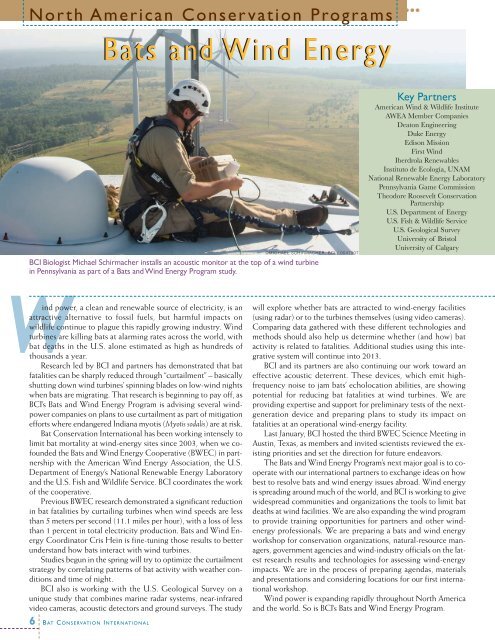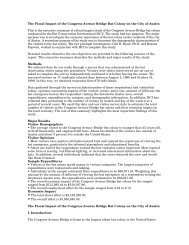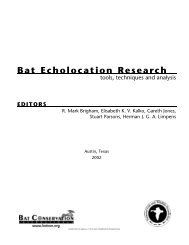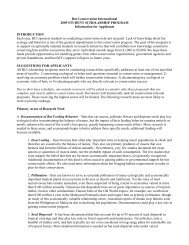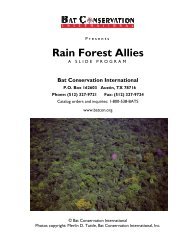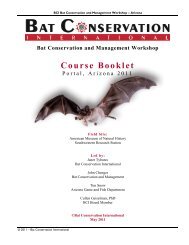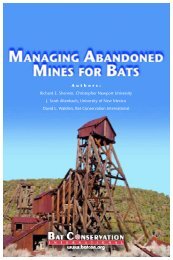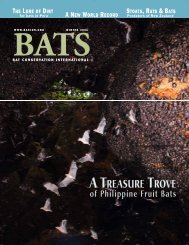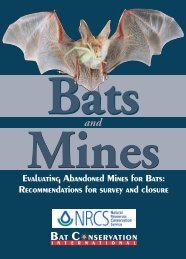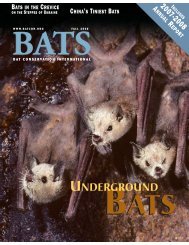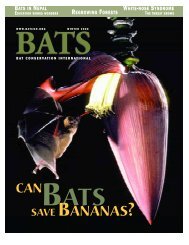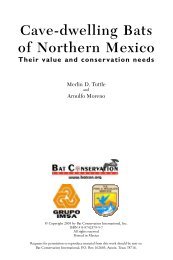Annual Report_09-10 - Bat Conservation International
Annual Report_09-10 - Bat Conservation International
Annual Report_09-10 - Bat Conservation International
Create successful ePaper yourself
Turn your PDF publications into a flip-book with our unique Google optimized e-Paper software.
nor th american Conser vation Programs<br />
<strong>Bat</strong>s and Wind energy<br />
©MICHAEL SCHIRMACHER, BCI / 0047907<br />
BCi Biologist Michael schirmacher installs an acoustic monitor at the top of a wind turbine<br />
in Pennsylvania as part of a <strong>Bat</strong>s and Wind energy Program study.<br />
Key Partners<br />
American Wind & Wildlife Institute<br />
AWEA Member Companies<br />
Deaton Engineering<br />
Duke Energy<br />
Edison Mission<br />
First Wind<br />
Iberdrola Renewables<br />
Instituto de Ecología, UNAM<br />
National Renewable Energy Laboratory<br />
Pennsylvania Game Commission<br />
Theodore Roosevelt <strong>Conservation</strong><br />
Partnership<br />
U.S. Department of Energy<br />
U.S. Fish & Wildlife Service<br />
U.S. Geological Survey<br />
University of Bristol<br />
University of Calgary<br />
W<br />
ind power, a clean and renewable source of electricity, is an<br />
attractive alternative to fossil fuels, but harmful impacts on<br />
wildlife continue to plague this rapidly growing industry. Wind<br />
turbines are killing bats at alarming rates across the world, with<br />
bat deaths in the U.S. alone estimated as high as hundreds of<br />
thousands a year.<br />
Research led by BCI and partners has demonstrated that bat<br />
fatalities can be sharply reduced through “curtailment” – basically<br />
shutting down wind turbines’ spinning blades on low-wind nights<br />
when bats are migrating. That research is beginning to pay off, as<br />
BCI’s <strong>Bat</strong>s and Wind Energy Program is advising several windpower<br />
companies on plans to use curtailment as part of mitigation<br />
efforts where endangered Indiana myotis (Myotis sodalis) are at risk.<br />
<strong>Bat</strong> <strong>Conservation</strong> <strong>International</strong> has been working intensely to<br />
limit bat mortality at wind-energy sites since 2003, when we cofounded<br />
the <strong>Bat</strong>s and Wind Energy Cooperative (BWEC) in partnership<br />
with the American Wind Energy Association, the U.S.<br />
Department of Energy’s National Renewable Energy Laboratory<br />
and the U.S. Fish and Wildlife Service. BCI coordinates the work<br />
of the cooperative.<br />
Previous BWEC research demonstrated a significant reduction<br />
in bat fatalities by curtailing turbines when wind speeds are less<br />
than 5 meters per second (11.1 miles per hour), with a loss of less<br />
than 1 percent in total electricity production. <strong>Bat</strong>s and Wind Energy<br />
Coordinator Cris Hein is fine-tuning those results to better<br />
understand how bats interact with wind turbines.<br />
Studies begun in the spring will try to optimize the curtailment<br />
strategy by correlating patterns of bat activity with weather conditions<br />
and time of night.<br />
BCI also is working with the U.S. Geological Survey on a<br />
unique study that combines marine radar systems, near-infrared<br />
video cameras, acoustic detectors and ground surveys. The study<br />
will explore whether bats are attracted to wind-energy facilities<br />
(using radar) or to the turbines themselves (using video cameras).<br />
Comparing data gathered with these different technologies and<br />
methods should also help us determine whether (and how) bat<br />
activity is related to fatalities. Additional studies using this integrative<br />
system will continue into 2013.<br />
BCI and its partners are also continuing our work toward an<br />
effective acoustic deterrent. These devices, which emit highfrequency<br />
noise to jam bats’ echolocation abilities, are showing<br />
potential for reducing bat fatalities at wind turbines. We are<br />
providing expertise and support for preliminary tests of the nextgeneration<br />
device and preparing plans to study its impact on<br />
fatalities at an operational wind-energy facility.<br />
Last January, BCI hosted the third BWEC Science Meeting in<br />
Austin, Texas, as members and invited scientists reviewed the existing<br />
priorities and set the direction for future endeavors.<br />
The <strong>Bat</strong>s and Wind Energy Program’s next major goal is to cooperate<br />
with our international partners to exchange ideas on how<br />
best to resolve bats and wind energy issues abroad. Wind energy<br />
is spreading around much of the world, and BCI is working to give<br />
widespread communities and organizations the tools to limit bat<br />
deaths at wind facilities. We are also expanding the wind program<br />
to provide training opportunities for partners and other windenergy<br />
professionals. We are preparing a bats and wind energy<br />
workshop for conservation organizations, natural-resource managers,<br />
government agencies and wind-industry officials on the latest<br />
research results and technologies for assessing wind-energy<br />
impacts. We are in the process of preparing agendas, materials<br />
and presentations and considering locations for our first international<br />
workshop.<br />
Wind power is expanding rapidly throughout North America<br />
and the world. So is BCI’s <strong>Bat</strong>s and Wind Energy Program.<br />
6 B aT C o n s e rvaT i o n i n T e r n aT i o n a l


